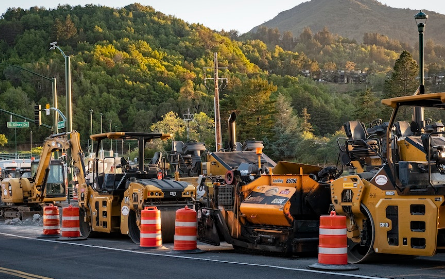
Public Projects & Preliminary Notices: Preliminary Notices Aren’t Just for Private Projects
Do you know there are 19 states that require a preliminary notice be served to protect bond claim or public improvement lien rights? A common misconception is that preliminary notices are only required for private projects (securing mechanic’s lien rights), but that’s just not true. In today’s post we are going to review the 19 states with preliminary notice requirements on public projects.
19 States with Preliminary Notices for Public Projects
Arizona, California, Florida, Georgia, Iowa, Louisiana, Massachusetts, Michigan, Montana, Nevada, New Jersey, North Carolina, Ohio, South Carolina, Texas, Utah, Washington, Wisconsin and Wyoming all have a preliminary notice requirement for public projects.
Arizona: 20 days from first furnishing
Serve notice upon the prime contractor within 20 days from first furnishing materials or services. A late notice may be served, but the bond claim, when later served, will only be effective for materials and services provided 20 days prior to serving the notice and thereafter. Serve an amended notice if the contract amount stated within your notice increases by 20% or more.
California: 20 days from first furnishing
Serve notice upon the prime contractor and public entity within 20 days from first furnishing materials or services. A late notice may be served, but the stop notice, when later served, will only be effective for materials and services provided 20 days prior to serving the notice and thereafter.
Florida: 45 days from first furnishing
Serve notice upon the prime contractor prior to or within 45 days from first furnishing materials or services. When supplying specially fabricated materials, serve notice prior to or within 45 days from the date fabrication begins. The notice must be received within the 45-day period.
Georgia: 30 days after first furnishing
Serve Notice to Contractor upon the prime contractor within 30 days after first furnishing materials or services, or within 30 days from the filing of the Notice of Commencement, whichever is later.
Iowa: 30 days after first furnishing
Serve notice upon the prime contractor within 30 days after first furnishing materials or services. No notice is required when contracting directly with the prime contractor.
Louisiana
Lessor’s Notice: Serve a copy of the lease upon the owner and prime contractor within 10 days after the equipment is first placed on the project site.
Notice of Non-Payment: Serve notice of non-payment upon the owner and prime contractor within 75 days from the last day of the month for EACH month in which materials were furnished, but within the period in which a sworn statement must be filed.
Massachusetts: 20 days from receiving final written approval for specially fabricated materials
When furnishing specially fabricated materials, a notice may be served upon the prime contractor within 20 days from receiving final written approval for such materials. Serving the notice will protect the right to serve a bond claim even if the materials are not incorporated into the project.
Michigan: 30 days from first furnishing
Serve notice upon the prime contractor within 30 days from first furnishing materials or services.
Montana: 30 days after first furnishing
Serve notice upon the prime contractor after first furnishing, but within 30 days from first furnishing materials or services.
Nevada: 30 days after first furnishing
Serve notice upon the prime contractor after first furnishing materials or services, but within 30 days from first furnishing materials or services. A late notice may be served, but the bond claim, when later served, will only be effective for materials or services provided 30 days prior to serving the notice and thereafter.
New Jersey
Bond Claim: Serve notice upon the prime contractor prior to furnishing materials or services. A late notice may be served, but the bond claim, when later served, will only be effective for materials and services provided after serving the notice.
Municipal Mechanic’s Lien: Serve notice upon the public entity within 20 days from first furnishing materials or services. A late notice may be served, but the lien, when later filed, will only be effective for materials and services provided after serving the notice.
North Carolina: 75 days from first furnishing
Serve a Notice of Public Subcontract on the prime contractor within 75 days from first furnishing materials or services.
A late notice may be served, but the bond claim, when later served, may only include materials or services provided within 75 days prior to serving the Notice of Public Subcontract and thereafter.
Ohio: 21 days from first furnishing
Serve notice upon the prime contractor within 21 days from first furnishing materials or services. A late notice may be served, but the bond claim, when later served, will only be effective for materials and services provided 21 days prior to serving the notice and thereafter.
South Carolina: as soon as possible
Serve a Notice of Furnishing upon the principal of the bond as soon as possible. The bond claim, when later served, will be limited to the amount owed by the principal of the bond at the time the Notice of Furnishing was received.
Texas
Notice of specially fabricated materials: Serve notice upon the prime contractor no later than the 15th day of the second month in which claimant received and accepted the order.
Notice of retainage: Serve notice upon the prime contractor no later than the 15th day of the second month following first furnishing materials or services, stating the total dollar amount to be retained and the general nature of the retainage agreement.
Notice of non-payment: Serve notice upon the prime contractor no later than the 15th day of the second month following each month in which materials or services were furnished.
Utah: 20 days from first furnishing
File preliminary notice with the State Construction Registry within 20 days from first furnishing materials or services or within 20 days from the filing of a notice of commencement, whichever is later. A late preliminary notice may be filed; however, the bond claim will only be enforceable for materials and services furnished 5 days or later after the notice is filed.
Washington
Bond Claim: Serve notice upon the prime contractor within 10 days from first furnishing materials or services.
Public Improvement Lien: Material suppliers must serve notice upon the prime contractor within 60 days from first furnishing materials or services. A late notice may be served, but the lien, when later filed, will only be effective for materials and services provided 60 days prior to serving the notice and thereafter.
Wisconsin: 60 days after first furnishing
Serve notice upon the prime contractor within 60 days after first furnishing materials or services.
Wyoming: 60 days from first furnishing
Serve notice upon the prime contractor within 60 days from first furnishing materials or services.
Remember, Just a Guideline for Notices & Public Projects
Please remember, this post provides a general guideline for these states. There may be circumstances where the notice is recommended but not required; frequently, when selling to the prime contractor on a public project, the notice isn’t required. Carefully review the information in The National Lien Digest or within each states’ statute to confirm you are serving the proper notice upon the proper parties within the proper time frame.
Even if the notice isn’t required, it’s a best practice to serve the notice so all parties within the ladder of supply are aware you are furnishing to the project!









